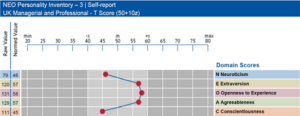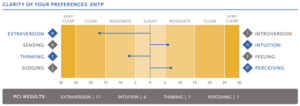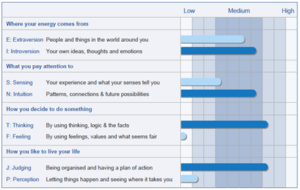
As coaches we want to help people develop, to become more rounded individuals with the flexibility and resilience to manage life’s challenges. This often means helping them to recognise, to access and develop different parts of their character. Part of that process can involve better understanding of their nature and personality, which is why many coaches use personality questionnaires. However, such questionnaires do not necessarily fit well with a coach’s aim of development and growth. This is because the model of personality they present is somewhat static and contains ambiguity. Let me set aside the nature-nurture issue for now and simply consider the way that personality profiles are usually presented – here is an example from one of the best known – the NEO PI-3:

Whatever characteristics are being used to describe personality (above is the Big Five), each one is presented as a point on a continuous scale. But what is the difference between high scores, low scores and average scores? Is an average score simply a less ‘intense’ version of high and low scores or are qualitatively different adjectives required? The problem with averages is that they can hide big differences, as illustrated below:


But now consider the possibility that people are both extravert and introvert. Most people do recognise elements of both – even those who report extreme scores. Perhaps a more useful (and more accurate) way to think about personality is to question how an individual manages to balance different degrees of opposing preferences, as illustrated here:
…………………………… ……………………………
……………………………
Extraversion Introversion
The implications of this approach are more extensive than many realise. At its heart is the implication that personality is a dynamic concept. For example, instead of ‘being an extravert’ the question becomes ‘how do I express both my extraversion and my introversion?’ Rather than being a point on a scale, personality is now a mosaic of characteristics – perhaps illustrated by this image and this quote:
‘Few men are of one, plain, decided colour; most are mixed, shaded and blended and vary as much from different situations as changeable silks do in different lights.’ Lord Chesterfield 1752
This approach fits better with the way that people adapt to different circumstances – and makes this more than simply a behavioural change; it becomes illuminating and expressing the many sides of my character. A further implication is addressing the frustration that people sometimes feel when answering a personality questionnaire. Have you ever felt like answering some of the statements with ‘it depends!’? People are usually encouraged to ignore this frustration and to just think of how they feel or act ‘typically’?
Once again, this is seeking an average rather than exploring the different sides of a person’s character. Taken to an extreme, consider how Dr Jekyll would need to answer to reflect his ‘typical’ self – and what would that potentially hide?
Viewing personality as comprised of different characteristics that come to the fore in different circumstances is not new. For example, Carl Jung (who coined the terms extraversion and introversion), proposed that personality involves opposing preferences. Unfortunately, his concept of opposite is often misunderstood to mean that one end denies the other (e.g. when it is light it cannot be dark). However, Jung proposed that people are both but with different ways of balancing them. Unfortunately, the best-known personality questionnaire based on Jung is the MBTI which then proceeds to present a person’s profile in a one-sided way:

Perhaps a better way to represent this more dynamic approach to personality is to show the degree to which the person recognises the two poles as illustrated here using a profile from the TDI (Type Dynamics Indicator):

The profile above shows a person quite closely balanced between Introversion and Extraversion but much more one-sided for Thinking and Feeling. This approach need not be restricted to questionnaires based on Jung’s psychological type. Consider, for example, the concept of Optimism and Pessimism. Whichever end of the scale a person prefers, they can benefit by understanding both characteristics. A one-sided optimist may bounce back from disappointment more readily – but may also fail to see potential negatives. A one-sided pessimist may focus on the potential negatives and hence avoid opportunities that present themselves. This is a philosophically different way of thinking about personality – and means that we help people to recognise their many sides and to help them emerge rather than thinking of them as ‘not me’ or simply as possible behaviours to learn.
Hence reframing personality as managing opposing tendencies helps address ‘the problem of one-sidedness’. To explore this idea more deeply, here are a couple of videos plus a book and an article to get you going:
Are we fighting the wrong battles (57 mins)
Myers-Briggs Typology vs. Jungian Individuation: Overcoming One-Sidedness in Self and Society

Roy Childs, Managing Director of Team Focus, is an Associate Fellow of the British Psychological Society and, like many other senior staff members, a Chartered Occupational Psychologist. His background in psychometrics includes having worked with some of the best-known authors of personality questionnaires including Ray Cattell (16PF) and Will Schutz (FIRO). With Team Focus he has developed a new range of instruments designed to bring psychometrics into the 21st century.
Roy runs the widest range of BPS recognised qualifying courses in the UK and his publications include “the Psychometric Minefield”; “Emotional Intelligence and Leadership”; “The Big Five – Bring a little colour into your lives”; “Coaching with FIRO Element B” published in the book “Psychometrics in Coaching”, ‘Action Learning Supervision’ published in the book “Coaching Supervision” and ‘The Relational lens’ published by Cambridge University Press.
Read more blogs from Roy Childs: How to challenge what I believe about myself